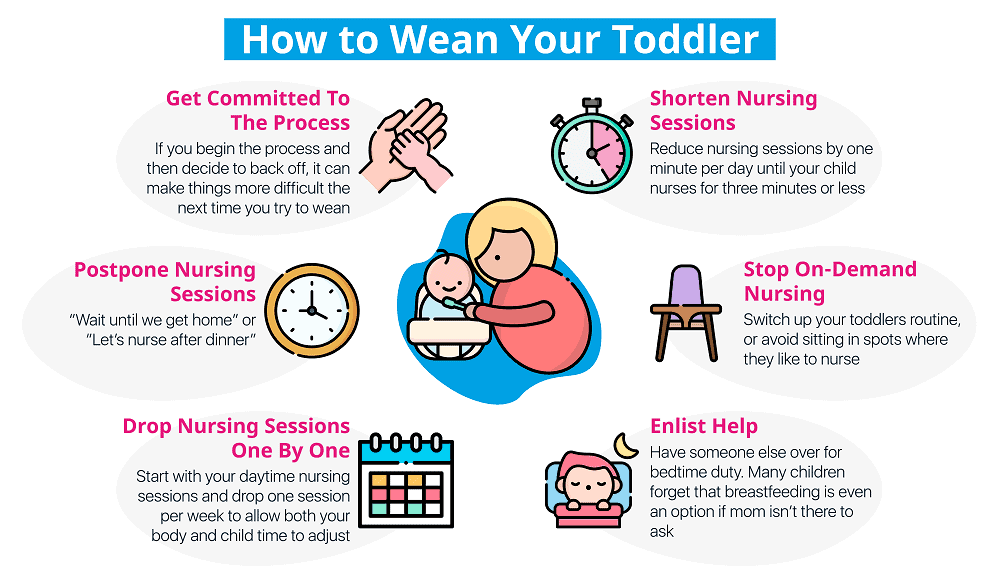Have you successfully breastfed your child through the infant phase and well into the toddler years? Congratulations, that’s something you should be incredibly proud of! Extended breastfeeding takes commitment.
But now that your child is older, how do you stop breastfeeding?
Having been through this experience many times, we know it’s possible to stop nursing your older child without a lot of drama. We’ll explain all you need to know about how to stop breastfeeding your toddler and provide six steps to lead you through the process.
Key Takeaways
- Weaning is the process of stopping breastfeeding an older child.
- To ensure that your child’s nutrition is still met, focus on offering enough additional calories throughout the day as you remove breast milk as a food source.
- To reinforce your child’s sense of security after breastfeeding has been removed, find a nursing substitute such as milk in a special sippy cup, a pacifier, a water bottle, a story with mom, soothing music, or five minutes of snuggle time.
- Be mindful that weaning can be as stressful on your body as it is on your toddler’s emotions. Gradual weaning is best to prevent breast engorgement, clogged milk ducts, and mastitis.
What To Know About Weaning
Before you begin the weaning process, there are a few things you need to know about your child’s nutrition, developmental stage, and the physical effects of weaning on your own body.
How Will It Affect Their Nutrition?
One of the first things you’re probably concerned about is your toddler’s nutrition. It’s impossible to know precisely how much they’re getting from breast milk on a regular basis. Some mothers may be producing nearly nothing, while others produce quite a bit of milk.
Since breastfeeding provides your child with more calories, nutrients, and fat, what you should focus on when weaning your child is making sure you’re still offering enough additional calories throughout the day.
As you remove breast milk as a food source, you’ll probably notice an increase in your child’s solid food intake. Try to ensure your child is receiving plenty of nutrients from the food you offer. However, don’t get so caught up with tracking your child’s food intake that you make yourself crazy.
Take Note
Instead, strive for a nutritionally balanced week. Children’s bodies are intuitive, and they will eat what they need. Your job is simply to make a variety of foods available at regular intervals, and your child will decide whether to eat and how much.
How Will It Affect Their Development?
For toddlers, rituals and routines present a sense of security and predictability as they go through their day. For your breastfeeding toddler, nursing may have become part of this routine and contributes to their sense of stability.
You’ll need to find a way to reinforce their need for security after breastfeeding has been removed. You can do this by identifying a nursing substitute. It may be an oral replacement or simply a soothing activity. Some ideas for a substitute are:
- Milk in an extra-special sippy cup they picked out themselves.
- A pacifier (if your child still uses one; don’t introduce one at this age if they don’t already use it).
- A water bottle.
- A story with mom.
- Soothing music.
- Five minutes of snuggle time.
When your child asks to nurse after you’ve either dropped certain nursing sessions or weaned altogether, offer them their special substitute. You know your child best, so choose something they will enjoy and find comforting.
It is also helpful that your child is still easily distractable at this age. This means when they get upset because you prevent them from nursing, distraction by substitution can be a great strategy to satisfy them.
How Will It Affect You?
As you wean, be mindful that weaning can be as stressful on your body as it is on your toddler’s emotions. Your breasts are a milk factory accustomed to producing milk for your toddler, and they produce to keep the supply in line with demand.
As you decrease your nursing length and frequency, your body will respond by reducing its supply. Abrupt weaning, however, has the potential to cause breast engorgement, clogged milk ducts (which can be painful), and mastitis (if they become infected).
Clogged milk ducts have the following symptoms (1):
- A small, hard spot in the breast.
- Swelling or bruising.
- Localized breast tenderness.
- A hot feeling in the breast.
If you have a clogged milk duct, massage it to try to release the milk, place warm compresses on it, and continue nursing from that side until the clogged duct is resolved.
If the discomfort persists and you develop any of the following symptoms, contact your physician as you may have mastitis, which is an infection that can require antibiotics (2):
- Fever.
- Discharge (pus) from the breast.
- Chills.
- Flu-like symptoms.
- Quick onset of feeling ill.
Weaning Step by Step
Now that you know everything you need to know about the science behind weaning a toddler, here are the 6 steps you should follow.
1. Get Committed To The Process.
Mom, the first step is yours alone. While weaning will free you of the physical burden of nursing, it can also be unexpectedly emotional for you to realize the days of intense physical connection with your child are coming to an end.
Prepare yourself before jumping in, and be committed! If you begin the process, then decide to back off, it can make things more difficult the next time you try to wean.
At the same time, it’s important to watch your child’s cues, just like you did when starting to breastfeed. If weaning is going too fast, or if your child just isn’t ready, you may see an increase in toddler tantrums. You may want to slow down the changes for a few days or weeks.
Editor's Note:
Michelle Roth, BA, IBCLC2. Talk to Your Toddler.
Most toddlers can understand a lot of things and even be reasoned with if they’re creeping toward preschool age. So, talk with your child often about how breastfeeding is for babies and they are growing up and becoming a big kid. Let them know that soon they will no longer be nursing.
Very young toddlers can begin to understand postponement, too. For instance, let them know they can’t nurse when it’s light out, only when it’s dark. Or tell them they can nurse but not until after dinner.
Editor's Note:
Michelle Roth, BA, IBCLC3. Stop On-Demand Nursing.
Every mother-child relationship is different, but by this age, many toddlers will have fallen into a routine and will expect nursing sessions at set times (after waking, before nap, at bedtime).
However, if this is not the case in your home and you nurse at irregular intervals based on your child’s request, it’s time to stop.
If your child asks to breastfeed outside of “regular” breastfeeding sessions, gently refuse, but offer the substitute you have identified, and reassure them you will be happy to nurse them later, before their nap, for example.
4. Shorten Nursing Sessions.
While your body stops producing a large volume of milk, gradually tapering off your nursing is a good idea both for your child’s emotional adjustment as well as your physical comfort.
Remember
Reduce nursing sessions by one minute per day until your child nurses for three minutes or less. Or nurse only for the length of a nursery rhyme or favorite song. I can remember times when I would allow nursing only until I made it through the ABCs!
If your child is upset when the nursing session ends before they’d like it to, offer them the substitute you have identified.
5. Drop Nursing Sessions One by One.
Starting with your daytime nursing sessions, drop one session per week to allow both your body and child time to adjust. This step will vary from mother to mother. Some may still be nursing five times each day, while others may only be nursing twice.
Generally, the bedtime nursing session is the most difficult one to drop as children use it primarily for self-soothing and comfort before going to sleep. Save this one for last.
If your child fusses and asks to breastfeed at a time when you’ve already dropped that nursing session, offer them the substitute.
Take Note
6. Enlist Help.
When you’re ready to drop your final nursing session, it’s time to rally the troops! Have someone else (husband/mom/friend) cover bedtime duty. Many children forget that breastfeeding is even an option if Mom isn’t there to ask.
Make sure your sidekick is on the same page about not giving in to the child’s pleas and that they know about the acceptable substitutes to offer if the child asks about breastfeeding.
FAQs
Winning The Weaning Battle
To summarize, here are the 6 steps to wean your toddler successfully:
- Commit to the process.
- Talk to your toddler about the changes.
- Stop on-demand and irregular nursing.
- Shorten your nursing sessions.
- Reduce your nursing sessions one by one.
- Have your partner take over bedtime duty.
Weaning a toddler can seem daunting, but it doesn’t have to be. If you have a rock-solid strategy before you begin, wean slowly, and offer a comforting substitute to your child, you can stop breastfeeding with minimal drama.















